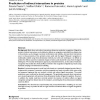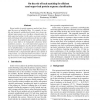91 search results - page 8 / 19 » Exploiting Sequence Dependencies in the Prediction of Peroxi... |
BMCBI
2006
13 years 7 months ago
2006
Background: Both direct and indirect interactions determine molecular recognition of ligands by proteins. Indirect interactions can be defined as effects on recognition controlled...
BMCBI
2010
13 years 7 months ago
2010
Background: Establishing the relationship between an organism's genome sequence and its phenotype is a fundamental challenge that remains largely unsolved. Accurately predict...
EVOW
2010
Springer
13 years 11 months ago
2010
Springer
A challenging problem in bioinformatics is the detection of residues that account for protein function specificity, not only in order to gain deeper insight in the nature of functi...
BMCBI
2004
13 years 7 months ago
2004
Background: The function of a novel gene product is typically predicted by transitive assignment of annotation from similar sequences. We describe a novel method, GOtcha, for pred...
BIBM
2008
IEEE
13 years 9 months ago
2008
IEEE
Recent studies in protein sequence analysis have leveraged the power of unlabeled data. For example, the profile and mismatch neighborhood kernels have shown significant improveme...


